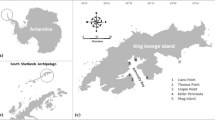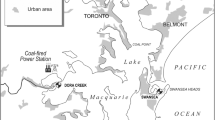Abstract
Concentrations of Zn, Cu, Al, Fe, and Mn were determined in Chironomidae (Diptera) larvae sampled from three sites within eight peatlands, located in south-central Ontario, Canada. The eight peatlands displayed a range in pH and alkalinity and were classified abiotically (i.e., chemically, hydrologically) and biotically (i.e., dominant vegetation present) as mineral-poor, moderately poor, or as mineral-rich fen. Surface peats of mineral-poor fens were distinct from those of moderately poor and mineral-rich fens; mineral-poor fens contained higher concentrations of organic matter with low concentrations of easily reducible Mn vs. the moderately poor and mineral rich fens. A one-way nested ANOVA indicated that chironomid metal concentrations were peatland dependent (P<0.05). To determine if differences in chironomid metal concentrations among the peatlands could be related to peat geochemistry, an R2 MAX procedure using peat geochemistry as the independent variable and chironomid metal concentrations as the dependent variable was applied. Peat geochemistry was defined as concentrations of peat organic matter, reducible Fe (Fe oxides), reducible Mn (Mn oxides) and easily reducible metal (where metal = Zn, Cu, Al, Mn and Fe), and reducible metal and organically bound metal. Chironomids from mineralrich peatlands, i.e., peatlands low in organic matter with high concentrations of reducible Mn and Fe or easily extractable metal contained greater concentrations of Zn, Mn, and Fe vs. chironomids sampled from mineral poor peatlands, i.e., peatlands with high concentrations of peat organic matter and low concentrations of reducible Mn or easily extractable metal. In contrast, Cu concentrations were greatest in larvae sampled from mineral-poor vs. mineral-rich peatlands. Aluminum larvae concentrations were independent of peat geochemistry. We suggest that bioavailability of metals such as Zn, Fe, and Mn will be greater to invertebrates inhabiting mineral rich vs. mineral poor fens, whereas greater chironomid Cu concentrations will be found in chironomids sampled from mineral poor fens. Differences in metal availability to invertebrates among peatland types has important implications when comparing the impact of contaminant transfer to higher trophic levels among different types of peatlands.
Similar content being viewed by others
References
Albers PH, Camardese MB (1993a) Effects of acidification on metal accumulation by aquatic plants and invertebrates. 1. Constructed wetlands. Environ Toxicol Chem 12:959–967
Albers PH, Camardese MB (1993b) Effects of acidification metal accumulation by aquatic plants and invertebrates. 2. Wetlands, ponds and small lakes. Environ Toxicol Chem 12:969–976
Bendell-Young LI, Harvey HH, Dillon PJ, Scholer PJ (1989) Contrasting behaviour of manganese in the surficial sediments of thirteen south-central Ontario lakes. Science Total Environ 87/88:129–139
Bendell-Young LI, Harvey HH (1992a) Metal concentrations in chironomid larvae in relation to the geochemical characteristics of surficial sediments. Arch Environ Contam Toxicol 21:202–211
—, — (1992b) Geochemistry of Mn and Fe in lake sediments in relation to lake acidity. Limnol Oceanogr 37:603–613
Bendell-Young LI, Dutton M, Pick FR (1992a) Contrasting two methods for determining trace metal partitioning in oxidized sediments. Biogeochemistry 17:15–29
Bendell-Young LI, Chouinard J, Pick FR (1992b) Contrasting the geochemistry of trace metals among bogs and fens. Final report to the World Wildlife Toxicology Fund. World Wildlife Fund, Toronto, Ontario, 32 pp
Bendell-Young LI, Pick FR (1993) Contrasting the geochemistry of Al among peatlands. Water Air Soil Pollu (in press)
Campbell PJC, Lewis A, Chapman PM, Crowder AA, Fletcher WK, Imber D, Luoma S, Stokes PM, Winfry M (1988) Biologically available metals in sediments. NRCC No. 27694. 298 pp
Environment Canada (1979) Analytical methods manual. Vol. 1. Inland water Directorate, Water Quality Branch, Ottawa, ON, Canada
Forstner U, Witman GTW (1981) Metal pollution in the aquatic environment, 2nd ed. Springer-Verlag, NY, 486 pp
Girard R, Reid RA, Snyder WR (1985) The morphometry and geology of Plastic and Heney Lakes and their catchments. Ontario Ministry of the Environment Data Report 85/1, Canada
Gorham E, Bayley SE, Schindler DW (1984) Ecological effects of acid deposition upon peatlands; A neglected field in “acid-rain” research. Can J Fish Aquat Sci 41:1256–1268
Harvey HH, Pierce RC, Dillon PJ, Kramer RJ, Whelpdale D (1981) Acidification in the Canadian aquatic environment: Scientific criteria for assessing the effects of acidic deposition on aquatic ecosystems. Associate committee on Scientific Criteria for Environmental Quality, National Research Council of Canada, Ottawa, Canada NRCC Publ No 18475, 369 pp
Hesslein RH (1976) An in situ sampler for close interval pore water studies. Limnol Oceanogr 21:912–914
Jeffries DS, Snyder WR (1983) Geology and geochemistry of the Muskoka-Haliburton study area. Data Rep. DR 83/2. Dorset Research Centre, Dorset, Ont, Canada
Luoma SN, Davis J (1983) Requirements for modeling race metal partitioning in oxidized estuarine sediments. Mar Chem 12:95–108
McLachline AJ, Cantrell MA (1976) Sediments development and its influence on the distribution and tube structure of Chironomus plumosus L. (Chironomidae:Diptera) in a new impoundment. Freshwater Biol 6:437–443
Mitsch JW, Gosselink JG (1986) Wetlands. Van Norstrand Reinhold Co, NY, 539 pp
National Wetlands Working Group (NWWG) (1988) Wetlands environments and classification. In: Wetlands of Canada. Ecological land classification. Series No. 24. Polyscience Publ Inc, Montreal, Quebec, Canada 452 pp
SAS Institute Inc. (1988) SAS/STAT user's guide, Release 6.03 edition. SAS Institute Inc, Cary, NC, 1028 pp
Shoykt W (1988) Review of the inorganic geochemistry of peats and peatland waters. Earth Sci Rev 25:95–176
Sokal RR, Rohlf FG (1990) Biometry, 2nd ed. WH Freeman, NY, 859 pp
Tessier A, Couillard Y, Campbell PJC, Auclair JC (1993) Modeling Cd partitioning in oxic lake sediments and Cd concentrations in the freshwater bivalve Anodonta grandis. Limnol Oceanogr 38:1–17
Author information
Authors and Affiliations
Rights and permissions
About this article
Cite this article
Bendell-Young, L., Chouinard, J. & Pick, F.R. Metal concentrations in chrionomids in relation to peatland geochemistry. Arch. Environ. Contam. Toxicol. 27, 186–194 (1994). https://doi.org/10.1007/BF00214262
Received:
Revised:
Issue Date:
DOI: https://doi.org/10.1007/BF00214262




